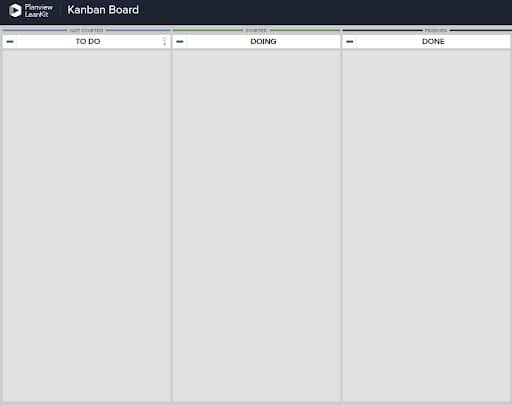Introduction to Kanban
What is Kanban?
Kanban is a visual method for managing workflow at the individual, team, and even organizational level. Pronounced “kahn-bahn,” the term translates from its original Japanese to “visual signal” or “card.”

Unlike other workflow management methods that force change from the outset, Kanban is about evolution, not revolution. It hinges on the fundamental truth that you must know where you are before you can get to your desired destination.
Kanban can be applied to virtually any type of work that follows a repeatable process; if your work follows the pattern of “To Do,” “Doing,” and “Done,” it can be managed on a Kanban board.
What is a Kanban Board?
Before we dive any deeper, let’s take a minute to explain what we mean when we talk about Kanban boards and cards.
Imagine a whiteboard, divided into vertical lanes. Each lane represents a step in your process, from “To Do,” to “Doing,” to “Done.”
In Kanban, work always begins on the left side of the board, and works its way to the right: The far left lane typically holds work items that have not been started, and the far right lane holds work items that have been completed.
In addition to visualizing the steps in your process, Kanban boards can also provide visibility into other information about your work, such as process policies (rules for using the board), and work-in-process (WIP) limits. You can learn more about Kanban boards.
What is a Kanban Card?
In Kanban, work items are represented by cards. You can imagine these as sticky notes on the whiteboard.

Each card, or sticky note, represents one work item. We share more about Kanban cards in depth in this article, but recommend first reading this overview of how Kanban boards and cards work.
How Kanban Boards and Cards Work
To illustrate how Kanban works, let’s say you want to use your Kanban board to visualize all the tricks you’d like to teach your new puppy to do: Sit, stay, down, come, shake. For the purpose of this example, your Kanban board can use the basic three-lane setup of “To Do,” “Doing,” and “Done.”
To represent these tasks on a Kanban board, you’d create a card for each of the tricks:
- Teach Max “sit”
- Teach Max “stay”
- Teach Max “down”
- Teach Max “come”
- Teach Max “shake”

If you haven’t started your training yet, then all the cards would be in your “To Do” lane. Once you begin working on them, you’d move them into “Doing.” When Max has successfully learned each trick, you’d move its respective card into “Done.”
Unlike a physical sticky note, a digital Kanban card gives you the option to add notes, attach files and links, and give updates on the work which you can use as reference, or share with anyone else who might be involved in the work.
If you’re sharing the responsibility of training Max with your partner (or just for your own reference), you might include these details within the Kanban card for “Teach Max sit:”
- A definition of “done”: Max has to successfully sit from the verbal command “sit” without having to repeat the command.
- Other details for how to complete the task: We will use a closed fist above his head along with the verbal command to signal “sit.” We will give him one treat every time he successfully sits.
- Tips for successfully completing the work: Link to a YouTube video, How to Teach Your Dog to Sit, from a professional dog trainer
- Updates in the form of comments on the card: “Practiced for 15 minutes today. Max sat on the first try about half of the time, but only if there was a treat involved. He seems to like the beef treats more than the peanut butter treats.”
Looking at your Kanban board, you can easily see how Max’s training is progressing: You can see that he’s successfully learned three of the five tricks and is actively working on the other two. By opening the other two tasks, you can learn more about how Max is progressing, and if your partner left any comments that might help you continue his progress.
The Kanban Method: Origins
Kanban is a method that was originally developed by Toyota to streamline automotive manufacturing processes. Inspired by the “just in time” ordering practices seen in grocery stores, Toyota line-workers used a Kanban (i.e., an actual card) to signal steps in their manufacturing process.
The original forms of Kanban were largely analog – physical boards and cards that were manually updated; since then, Kanban has gone digital.
Although physical Kanban boards and cards can be a helpful training tool for learning the basics of Kanban, the flexibility, functionality, and visibility of digital Kanban tools cannot be beat.
Key Kanban Practices and Concepts
Of course, the above explanation of Kanban boards and cards is extremely simple, but it helps to illustrate the basic way that Kanban boards are used. By moving cards from left to right through defined steps in a process, and communicating work details within the cards, you can visualize virtually any process, at any level of your organization.
Kanban is immensely helpful because it is extremely flexible – but there are some key Kanban practices and concepts that will guide you to success. We will share them here.
(Note: There are many ways to define Kanban; the intent in listing the core elements in this manner is not to introduce a new definition but to distill the common principles.)
1. Visualize work
By creating a visual model of your work and process, you can observe the flow of work moving through the Kanban system. Making the work visible, along with visual indications of blockers, bottlenecks, and queues, instantly leads to increased communication and collaboration. This helps teams see how fast their work is moving through the system and where they can focus their efforts to boost flow.
2. Limit work-in-process
By limiting how much unfinished work is in process, you can reduce the time it takes an item to travel through the Kanban system. You can also avoid problems caused by task switching and reduce the need to constantly reprioritize items. WIP limits unlock the full potential of Kanban, enabling teams to deliver quality work faster than ever in a healthier, more sustainable environment.
3. Focus on flow
Using work-in-process limits and team-driven policies, you can optimize your Kanban system to:
- Improve the flow of work
- Collect metrics to analyze flow
- Get leading indicators of future problems
A consistent flow of work is essential for faster and more reliable delivery, bringing greater value to your customers, team, and organization.

4. Continuous improvement
Once your Kanban system is in place, it becomes the cornerstone for a culture of continuous improvement. Teams measure their effectiveness by tracking flow, quality, throughput, lead times, and more.
Experiments and analysis can change the system to improve the team’s effectiveness. Continuous improvement is a Lean improvement technique that helps streamline workflows, saving time and money across the enterprise.
What is Kanban Used For?
If you’re like most knowledge workers, you’re probably already inundated with well-intentioned tools that just add work to your plate. Why start using Kanban?
Ask yourself the following questions:
- Does your brain always feel like you have a million tabs open?
- Do you feel like you’re always switching from one task to another, struggling to focus on any one thing long enough to make progress?
- Do you feel like you work nonstop, but are never as productive as you’d like to be?
- Does your team struggle with basic communication, causing issues such as duplicate effort, defects, rework, and more?
If you’ve answered yes to any of these questions, Kanban may be right for you. Many knowledge workers struggle with these problems and find clarity and freedom through Kanban.
Why Kanban Works
Today’s workforce is armed with retina-worthy smartphones and tablets, but plenty of information still comes our way as words on a screen. Text is everywhere. Between emails, Slack messages, formal and informal meetings, it’s hard to keep track of what needs to be done, and when.
While textual information fits certain scenarios, it is not a one-size-fits-all communication vehicle; Its effectiveness is lower than you might think. Why?
It starts with your brain.
A picture is worth a thousand words for scientific reasons. The brain processes visual information 60,000 times faster than text.
Forty percent of all nerve fibers connected to the brain are linked to the retina. Visual information comprises 90 percent of the data that comes to our brain, suggesting that our neurological pathways might even prefer pictures over text.
How Kanban Helps
Kanban takes information that typically would be communicated via words and turns it into brain candy. By turning all your “to-dos” into cards on a board, Kanban helps to clarify what’s important, helping you to stay focused on the highest-priority work. It provides a shared space where everyone involved in a piece of work can go to find the most up to date information.
When used effectively, Kanban can drastically reduce the amount of time teams spend in meetings that simply provide status updates.
Instead, teams can spend more time completing work, rather than talking about the work.
Kanban also standardizes cues and refines processes, which helps to reduce waste and maximize value. Seeing how your work flows within your team’s process lets you not only communicate status but give and receive context for the work.
Getting Started with Kanban
The first steps to embracing Kanban are to understand the basic principles of Kanban, and then work to reflect your current process on a Kanban board. From there, you can begin to unlock deeper levels of continuous improvement.
To continue learning about Kanban, we recommend the next article in this guide: What is a Kanban Board?
